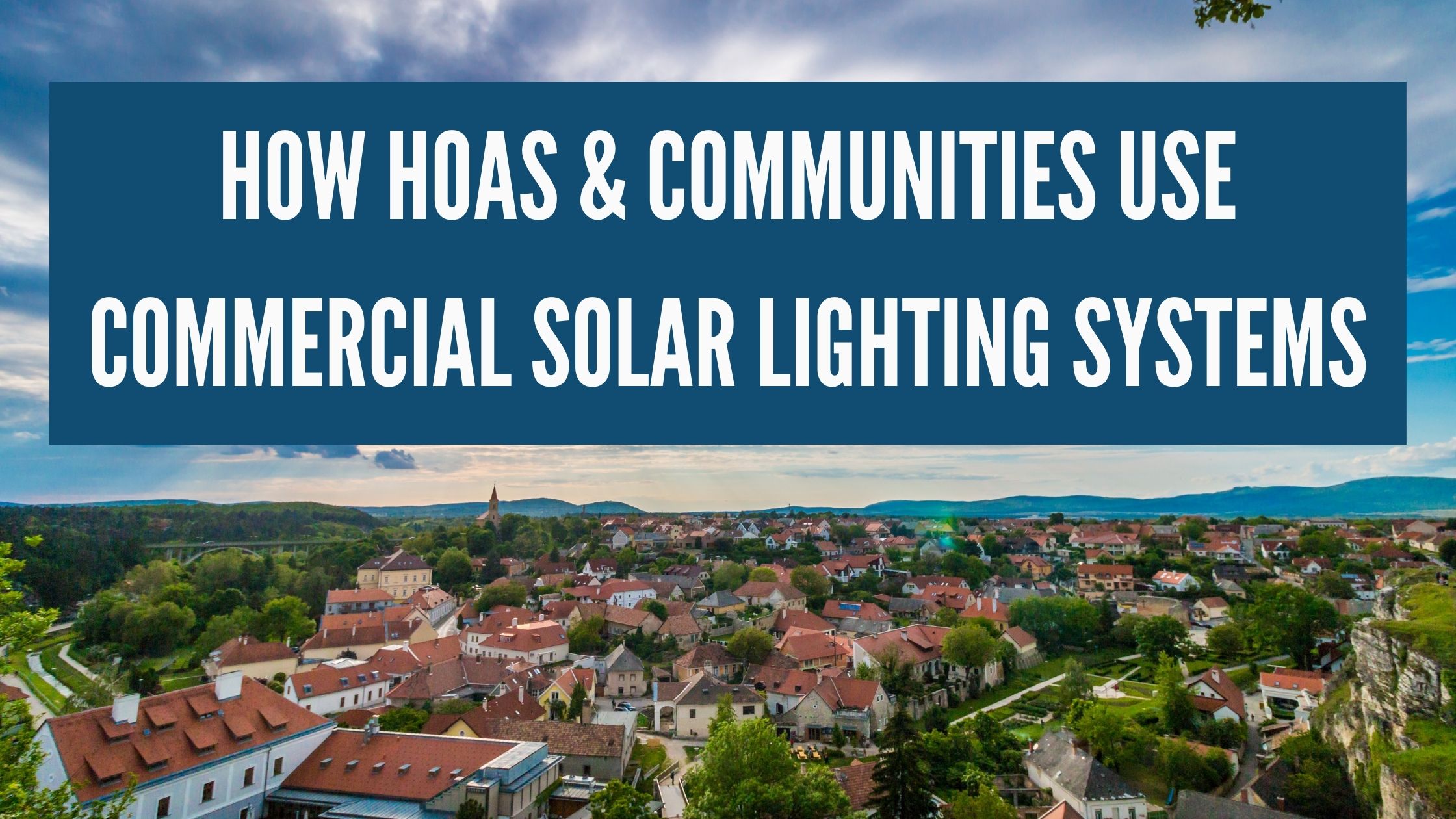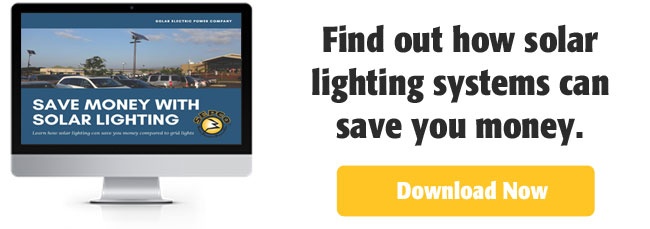How HOAs & Communities Use Commercial Solar Lighting Systems

Contents
Many homes are now installing solar on their roofs to help cut down individual costs and environmental impact. Many homeowners associations are currently looking for more ways to go green and save money as a community. In addition, implementing off-grid commercial solar lighting systems is a great way to implement solar on other projects around a neighborhood.
Since an HOA is responsible for paying for many amenities in a community, such as contracted services, utilities, insurance, taxes, and so much more, every dollar adds up. These fees are extended to the residents to the tune of $100 to upwards of $500 a month, and in some cases, special assessments increase this cost. As a result, it can be challenging to find ways for the community to save as a whole.
We wanted to showcase how a commercially designed solar lighting system can be used to reduce costs to the homeowners association and, in turn, the monthly fees for the residents that live there. These savings can also be used to provide upgrades to existing amenities and increase the savings for more extensive improvements down the line.
Benefits of Solar Lighting for HOAs & Communities
Solar lighting systems provide a grid-free solution to lighting areas around a community. It can help the HOA reduce costs from maintenance, reduce monthly energy costs, and even brighten dark areas around the community that the grid can't reach economically.
Solar lights can have a higher upfront cost when traditional electricity is installed, and functional, and the community wants to upgrade. However, there is still a good return on investment in less than half the lifespan of the systems. In addition, once the off-grid solar lighting systems are installed, there are no more electric bills from the energy company, and only a 5-to-10-year maintenance schedule is required, depending on the technology used.
With the increased use of LED fixtures, the lights can be installed to provide illumination directly to the area needed and not wasted into the night sky. The LED light fixtures also have a lifespan of 20+ years in many cases, making them last longer than most other types of lighting fixtures on the market.
Best of all, the community is no longer reliant on the electric grid to provide power and make sure the lights are on. Having an off-grid solution is especially important in areas where the electric grid is becoming unreliable or spotty and safety and security are of the utmost importance, or in areas where natural disasters can easily damage the grid power.
Considerations for HOAs
There are many considerations an HOA or community needs to consider when installing a solar lighting solution. Solar is a more significant investment in many cases, unlike what many power companies will provide at the start; however, down the line, more expensive rates can be added to increase the utility costs. Solar will not have an increased expenditure during the system's life since the system is paid for upfront, and the only maintenance required is the batteries.
Solar also provides an easier installation, unlike traditional electric lights. The installation will only require a pole to be set, either by burying the pole 5-7' in the ground or by creating a concrete base and installing everything on the pole. In addition, all the wiring is located between the solar panel, battery assembly, and light fixture, so no trenching or additional wiring is required for the system.
For developed areas, existing poles are not usually owned by the HOA and will need to be replaced (they would have required replacing anyways). But, first, the utility company can come to take back their poles. Plus, the existing poles are not designed to meet the wind load requirements of a solar solution, especially not if you are in a hurricane-prone area. Even if you own the poles, it is best to replace the poles with new ones rated to handle the new load.
Finally, what are the aesthetic requirements of the area? Decorative fixtures have a much higher upfront cost than their more industrial counterparts; however, they do provide the same light output in many cases. It is based on the budget of the community what style of solar lighting solution is used.
Types of Solar Lights used in HOAs
There are many applications where solar lighting can be installed in an HOA. From the main entrance signs to the various roadways and parking lots around the community, solar can be used for each type of application, down to the pathways and playgrounds. Let's look at each type of application and how solar can be used to provide a sustainable solution.
Solar Lights for Streets and Roadways
Communities are connected mainly by streets and roadways. These are typically two-lane areas where people do not travel too fast in their vehicles. These areas should be properly illuminated at night to allow cars to spot obstacles easily and keep residents safe while moving around the community.
Many utility companies think proper illumination is to have one light at an intersection, and that is all. Still, everyone knows that illuminating the entire area can drastically improve the safety of an area. The lighting doesn't need to be very bright, but enough to easily see people, cars, pets, etc.
Solar lighting systems can easily light up a roadway, making the traveling areas much safer. With new LED fixtures, the lights no longer shine into people's homes at night, keeping the light only where it is required. Many fixtures are now available with backlight control if the homes are located closer to the roadway.
Solar Lighting for Parking Lots
Not all communities have parking lots for residents. Sometimes there are small parking areas for guests. Sometimes everyone has their own driveways. One thing that gets forgotten a lot is the community area, such as clubhouses and pools. These almost always have a parking lot, and lighting isn't always the first thought when first developing an area.
Illuminating the parking lots decreases the community's liabilities while increasing the use of the space. Having a well-lit parking lot ensures that people can move from the building or pool to their vehicles safely by increasing the visibility of obstacles that could be in the way. The area should be well lit, but after the site's closing, it could either reduce to a lower output or turn off, depending on the needs of the residents.
Solar Lighting for Pathways, Bike Paths, and Walkways
Pathways around a community can be used for pedestrians to move around, people looking to get out and be active, walk their dogs, let their children play, and more. Ensuring these areas are well lit for people moving around after dark is essential to providing a community that can operate after dark.
Since dusk can be as early as 5 PM in many areas, especially in the winter months, expecting people not to go outdoors is unsustainable and incomprehensible. These areas should definitely be illuminated to allow the community residents to take advantage of the outdoors and move around without worry.
Low-level lighting is all that is required in these areas. Poles with fixtures around 12-15' above grade can still produce plenty of illumination in a large enough area. Solar pathway lighting systems do just this and don't need costly grid extensions to remote community areas. Best of all, the LED solar lighting systems won't cost the community more in maintenance and energy usage.
Solar Lighting for Signs
Entrance signs to a community are not always located in an area where electricity is available. Sometimes, the entrance can be quite remote from the actual community or in a median where power isn't available. In addition, grid extensions can be very costly later when you want to bring electricity to the signs to illuminate them at night.
Solar provides the perfect solution since the power generated is relatively close to the sign. You can install the solar solution to 100' from the sign; however, the fixtures can be located at the sign itself to ensure it is well illuminated. The solar can also be used to power channel letters and sign cabinets with internal LED modules as well.
Solar Lighting for Parks and Playgrounds
Understandably, parks and playgrounds are closed at night; however, some residents may have different thoughts and look to areas like this to hang out. There are two good reasons to illuminate these areas; vandalism and kids just hanging out can be a cause for concern in many communities. If someone gets hurt, the community can be held liable.
Instead, having this area well illuminated will cut down on these issues. If the kids are hanging out, residents can easily see them, and they are much less likely to get injured on the equipment. In addition, if someone is causing issues or vandalizing the area, residents or security cameras can easily spot this before it escalates.
Solar Lighting for Community Mailbox
Many residential communities have a community mailbox area. Unfortunately, these areas are not always located in a well-lit area, making it difficult and even unsafe for residents to check their mail after dark.
Instead, a well-placed solar lighting solution can provide the needed illumination for the community mailbox area. The lighting can be either by providing an overhead light, like a streetlight, or a building-mounted light system for shelter structures.
The light also doesn't need to operate all night. It can either work at a reduced output with motion activation for full intensity or run till a set time at night, say midnight. This type of operation lowers the solar requirements and ensures plenty of illumination when people need to check their mail.
Ways Communities Can Save
Communities can take advantage of savings through various avenues. If the HOA doesn't have the funds available all at once, many financing companies exist for HOAs and communities to finance their solar aspirations. The loan can then be paid back over time with the utility savings from the HOA dues.
Another way is to implement a special assessment in the community. A special assessment is not the most popular way to handle such a large purchase. Still, over time, you can pass the savings on to the members by reducing the dues since there will be no additional utility bills for the lighting in the area.
Holding fundraisers, looking for grants and other financial incentives available in your local area, and speaking with your community will show any different ways you can finance the project. For projects where the utility doesn't exist already, there may be incentives provided by your power company or a local government that can help provide a financial incentive to use a renewable source of energy.
Check out some more information on funding choices for your solar lighting project.
Conclusion
There are many benefits to how HOAs and communities can use commercial solar lighting systems. From providing financial savings, reducing their need for outside energy sources, increasing their overall green image, and providing a solution to the community lighting needs. There are many ways an HOA can provide an excellent experience for their community and ensure the safety and security of the residents, primarily through increased illumination in community spaces.
Do you want to see if your community can benefit from installing a commercial solar lighting solution? Then, contact your solar lighting specialist and see what is available and how your community can save.

